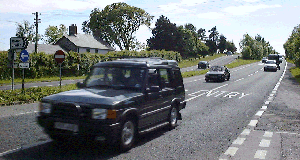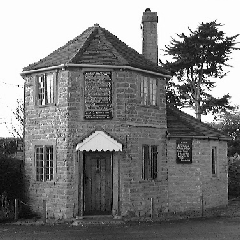
Since the departure of the Roman legions from the British Isles at the beginning of the 5th century until well into modern times, the term "road " signified more a route or track than the made-up roads we would recognise as such today. At best, they were rutted and dusty during the dry days of the summer, quagmires in wet weather.
The Romans were the first to realise the political importance of good land communication and built an extensive system of roads throughout their empire, including Britain, to facilitate the rapid movement of their legions, supplies and messengers. These roads were allowed to decay after the withdrawal of the Roman legions from Britain.
It was not until 1555, the second year of the short reign of the Tudor Queen Mary I, that parliament passed an Act making parishes responsible for the maintenance of the roads within their boundaries.
|
Compulsory labour for the maintenance of roads was not abolished until 1836. |
Under the 1555 Act, Waywardens had to be appointed in each parish to take responsibility for the roads within the parish; each parishioner owning a ploughland had to provide a cart for the repair of the roads for four days annually; and each able-bodied householder had to provide four days' labour annualy (increased to six days in 1691). Despite the Act and its provisions, there was little actual improvement in the condition of the roads.
|
In France, Colbert began a planned national road system in the 17th century and this was improved and extended by Napoleon.
|
The arrival of the Industrial Revolution which centralised much production which had previously taken place in widely dispersed cottages into factories, brought about the need for better transport. Although this first took the form of the many canals which traverse England, a vast improvement in roads followed and was almost entirely due to the Turnpike Trusts.
|
With no proper surface to the roads, they were liable to damage by livestock and parishes impounded stray livestock.
|
|
The turnpike trusts were more often than not also responsible for the repair and sometimes building or rebuilding of bridges.
|
A Turnpike Trust was a group of people or, rarely, and indivudual who were empowered by a private Act of parliament to take over a section of road, erect gates upon it and charge tolls to the users of the "Turnpikes", as the roads became known, in return for keeping the roads in good repair.
|
In the days of horse-drawn transport and when livestock were driven along the roads, the scrapings of the parish roads must have been a valuable resource as fertilizer. see: Milborne Port, Somerset
|
| |
The first of many such Acts was passed in 1663 but it was not until the 18th century, and particularly in the middle of that century, that turnpike acts became common and, eventually, all the main roads in the coutry were turnpiked.
Not all main routes were turnpiked and all road which were not remained the reponsibility of the parish. How effective turnpiking was depended on the experience and competence of the turnpike's surveyor and whether the tolls raised were sufficient to cover the initial loan, continuing running expenses and leave sufficient for running repairs.
The turnpike trusts usually took over existing roads or straightened routes across open country; wherever possible the trusts preferred the readily drained hilltop routes rather than parallel valley roads.
It is difficult to estimate how good the surfaces of the roads were under the care of the trusts but it seems certain that, although the standards must have varied in proportion to local conditins and the revenue raised from travellers, they were much better than before the involvement of the trusts.
|
With no outdoor illumination in rural areas, drivers carried lanterns on their coaches so as to be seen by other on-coming riders or vehicles (no lanterns powerful enough to illuminate the road existed).
Country balls and dinner parties were planned to coincide with the full moon so that coachmen could see their way (thus, in Sense and Sensibility, Sir John Middleton apologizes for not having more people for the Dashwood ladies to meet when they come to stay with him as "he had been to several families in hopes of procuring some addition to their number, but it was moonlight and everybody was full of engagements.").
|
|
In the 15th century, the expression "turnpike" was used for a spiked barrier (which would 'turn' one's course). By the 17th century, it became commonly used to describe the barriers at which the road or bridge tolls had to be paid.
|
Macadam revolutionized road construction c.1811 with his cambered water-tight surface of rammed brocken stone. This made possible a standard of roads which had not been seen in Britain since the departure of the Roman legions. Despite the superiority of such roads, not all turnpike trusts were progressive nor solvent enough to adopt this new technology.
|
Many coachmen smuggled poached game from the provinces for sale by the London poulterers.
|
By 1841, many turnpike trusts had become so loaded with debt, a situation excarebated by poor management, they did not have the resources to maintain the roads in their care. An Act of Parliament of 1841 permitted Justices of the Peace to help the trusts from parish rates where necessary.
The arrival of the railways, particularly during the 1830s and 1840s, robbed the turnpike trusts of much of their traffic and the coaching revenue in particular. Parliament began to extinguish the less efficient turnpike trusts in 1864 throwing the maintenance of the roads onto the parish rate (as statute labour had been abolished in 1835). Central government were eventually forced to provide a quarter of the cost of maintaining dis-turnpiked roads from central funds.
Responsibility for the upkeep of roads was transfered from the Parishes to the newly-formed Highway Boards in 1862. By 1889, nearly all the trusts had expired and the maintenance of the main roads and former turnpikes became the responsibility of the newly-formed County Councils.
The introduction and rapid development of popular cycling in the last decade of the 19th century brought a new demand for a better surface on roads.
|
| | | The "Red Flag Act" of 1865 compelled any mechanically propelled vehicle to travel at or below 2 mph in town and 4mph in the countryside and to be preceeded by a man on foot carrying a red flag. The removal of these restrictions in 1897 of the restriction saw the introduction of steam-driven goods vehicles, especially for the carriage of heavy goods.
|
| |
| | |
The use of traffic lights predates the advent of mass motor car transport; a lantern with red and green signals was used at a London intersection to control the flow of horse-drawn vehicles and pedestrians as early as 1868.
Police Officer William Potts used railroad signals, with an amber light added, to conrol traffic When motorcars arrived. His manually controlled electric traffic lights were first installed in Detroit, Michigan, in 1920. The first automated traffic light was introduced later in 1920 by Garrett Morgan and first used in Cleveland, Ohio.
The development of motor-car construction was rapid and led to the introduction of a public motor-car service in the streets of affluent Bournemouth as early as c.1900, and by 1905, motor-buses began to make an appearance in large towns, closely followed by taxi-cabs.
it was only after the Great War of 1914-18 that road transport emerged as a force to seriously rival the railways as it was realised that the carriage of freight by road involved only a single journey without the need for trans-shipment. Motor-coach companies attracted customers from the railways on long-distance journeys and both trends progressed to the extent where they affected the dividends of railway companies.
|
Between the two World Wars, freight vehicles were petrol driven on four pneumatic tyres, six in the case of heavier vehicles. Most often they were constructed as a single unit, but sometimes consisted of a driver's cab and power unit and a seperate trailer. Steam-powered wagons with sold rubber tyres (which had fallen out of use otherwise) were still used for the transport of particularly heavy loads.
Long-distance passenger travel saw the emergance of long-wheelbase single-deck buses with four or six wheels and well-sprung for passenger comfort.
| By the time a scheme had been put forward in November 1933 to convert London's tram routes to trolley-bus routes, the trolley-buses had largely superceded trams in the provinces. |
In larger towns and cities, electrically-powered trolley-buses replaced earlier tramcars. Unlike their predecessors, trolley-buses could be driven in either direction by having a driver's cab at either end and, the layout of their over-head power supply cables permitting, were able to run close to the pavement to pick up and set off their passengers.
|
|
| | | Links to Other Pages on this Site
|
| |
| | |
|
| | | Links to Other Sites
|
| |
| | |
DORSET
Bridport Sherborne
SOMERSET
Recommend a Book for this Page
<a href=BAAAGBWQ.php title=" History of Roads ">Roads</a>
Hits on this page since December 6th| Jan | | |  | | Feb | | |  | | Mar | | |  | | Apr | | |  | | May | | |  | | Jun | | |  | | Jul | | |  | | Aug | | |  | | Sep | | |  | | Oct | | |  | | Nov | | | | | Dec | | |  |
current year:  | | previous year:  |
No messages posted on this page Only Members of the Site can post messages in this section. Signing in is easy from our Home Page. DISCLAIMER: Whilst we endeavour to ensure the content of this site is correct, we cannot undertake that information you find here, is, or will remain accurate and complete. We do not warrant that any information contained on this site is fit for any purpose. If you wish to place reliance on any such information you must check its accuracy by some other means before doing so. MEMBERS get aditional features on our pages and will soon be able to interact with the site and add their views and informastion. Sign up, from the Home-Page, is simple and involves typing in your email address and a password of your choice. If you are in any way connected with any location or interested in the subject mentioned on this page and have an hour or two a month to spare, we would welcome you as a local moderator - please email the webmaster by CLICKING HERE. Privacy Policy
|
|








